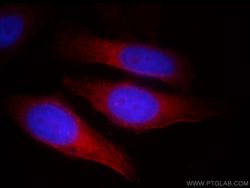18030-1-AP
antibody from Proteintech Group
Targeting: TNKS
ARTD5, PARP-5a, PARP5A, pART5, TIN1, TINF1, TNKS1
Antibody data
- Antibody Data
- Antigen structure
- References [8]
- Comments [0]
- Validations
- Western blot [1]
- Immunocytochemistry [1]
Submit
Validation data
Reference
Comment
Report error
- Product number
- 18030-1-AP - Provider product page

- Provider
- Proteintech Group
- Proper citation
- Proteintech Cat#18030-1-AP, RRID:AB_2303564
- Product name
- TNKS antibody
- Antibody type
- Polyclonal
- Description
- TNKS antibody (Cat. #18030-1-AP) is a rabbit polyclonal antibody that shows reactivity with human, mouse, rat and has been validated for the following applications: IF, IHC, IP, WB,ELISA.
- Reactivity
- Human, Mouse, Rat
- Host
- Rabbit
- Conjugate
- Unconjugated
- Isotype
- IgG
- Vial size
- 20ul, 150ul
Submitted references The dePARylase NUDT16 promotes radiation resistance of cancer cells by blocking SETD3 for degradation via reversing its ADP-ribosylation.
PARP5A and RNF146 phase separation restrains RIPK1-dependent necroptosis.
Study of the mechanism by which Xiaoyan decoction combined with E7449 regulates tumorigenesis in lung adenocarcinoma.
Identification and evaluation of a novel PARP1 inhibitor for the treatment of triple-negative breast cancer.
Iron promotes glycolysis to drive colon tumorigenesis.
Transferrin Receptor-Mediated Iron Uptake Promotes Colon Tumorigenesis.
Dihydroartemisinin suppresses proliferation, migration, the Wnt/β-catenin pathway and EMT via TNKS in gastric cancer.
circ5615 functions as a ceRNA to promote colorectal cancer progression by upregulating TNKS.
Wu W, Wu W, Zhou Y, Yang Q, Zhuang S, Zhong C, Li W, Li A, Zhao W, Yin X, Zu X, Chak-Lui Wong C, Yin D, Hu K, Cai M
The Journal of biological chemistry 2024 Mar;300(3):105671
The Journal of biological chemistry 2024 Mar;300(3):105671
PARP5A and RNF146 phase separation restrains RIPK1-dependent necroptosis.
Hou S, Zhang J, Jiang X, Yang Y, Shan B, Zhang M, Liu C, Yuan J, Xu D
Molecular cell 2024 Mar 7;84(5):938-954.e8
Molecular cell 2024 Mar 7;84(5):938-954.e8
Study of the mechanism by which Xiaoyan decoction combined with E7449 regulates tumorigenesis in lung adenocarcinoma.
Zheng X, Han Y, Gu L, Gao S, Lv Y, Li C
Journal of cellular and molecular medicine 2024 Jun;28(12):e18467
Journal of cellular and molecular medicine 2024 Jun;28(12):e18467
Identification and evaluation of a novel PARP1 inhibitor for the treatment of triple-negative breast cancer.
Gong R, Ma Z, He L, Jiang S, Cao D, Cheng Y
Chemico-biological interactions 2023 Sep 1;382:110567
Chemico-biological interactions 2023 Sep 1;382:110567
Iron promotes glycolysis to drive colon tumorigenesis.
Liu Z, Villareal L, Goodla L, Kim H, Falcon DM, Haneef M, Martin DR, Zhang L, Lee HJ, Kremer D, Lyssiotis CA, Shah YM, Lin HC, Lin HK, Xue X
Biochimica et biophysica acta. Molecular basis of disease 2023 Dec;1869(8):166846
Biochimica et biophysica acta. Molecular basis of disease 2023 Dec;1869(8):166846
Transferrin Receptor-Mediated Iron Uptake Promotes Colon Tumorigenesis.
Kim H, Villareal LB, Liu Z, Haneef M, Falcon DM, Martin DR, Lee HJ, Dame MK, Attili D, Chen Y, Varani J, Spence JR, Kovbasnjuk O, Colacino JA, Lyssiotis CA, Lin HC, Shah YM, Xue X
Advanced science (Weinheim, Baden-Wurttemberg, Germany) 2023 Apr;10(10):e2207693
Advanced science (Weinheim, Baden-Wurttemberg, Germany) 2023 Apr;10(10):e2207693
Dihydroartemisinin suppresses proliferation, migration, the Wnt/β-catenin pathway and EMT via TNKS in gastric cancer.
Ma Y, Zhang P, Zhang Q, Wang X, Miao Q, Lyu X, Cui B, Ma H
Oncology letters 2021 Oct;22(4):688
Oncology letters 2021 Oct;22(4):688
circ5615 functions as a ceRNA to promote colorectal cancer progression by upregulating TNKS.
Ma Z, Han C, Xia W, Wang S, Li X, Fang P, Yin R, Xu L, Yang L
Cell death & disease 2020 May 11;11(5):356
Cell death & disease 2020 May 11;11(5):356
No comments: Submit comment
Supportive validation
- Submitted by
- Proteintech Group (provider)
- Main image

- Experimental details
- Jurkat cells were subjected to SDS PAGE followed by western blot with 18030-1-AP(TNKS antibody) at dilution of 1:500
- Sample type
- cell line
Supportive validation
- Submitted by
- Proteintech Group (provider)
- Main image

- Experimental details
- Immunofluorescent analysis of HepG2 cells, using TNKS antibody 18030-1-AP at 1:25 dilution and Rhodamine-labeled goat anti-rabbit IgG (red). Blue pseudocolor = DAPI (fluorescent DNA dye).
- Sample type
- cell line
 Explore
Explore Validate
Validate Learn
Learn Western blot
Western blot ELISA
ELISA